Fire requirements for elevator halls. For transportation of fire departments and possible solutions
MINISTRY OF THE INTERIOR
RUSSIAN FEDERATION
FIRE SAFETY STANDARDS
ELEVATORS FOR TRANSPORTATION
FIRE DIVISIONS
IN BUILDINGS AND STRUCTURES.
GENERAL TECHNICAL REQUIREMENTS
NPB 250-97
MOSCOW1998
Developed by the Main Directorate of the State Anti fire service(GUGPS) of the Ministry of Internal Affairs of Russia, All-Russian Scientific Research Institute of Fire Defense (VNIIPO) of the Ministry of Internal Affairs of Russia, MOS OTIS.
Submitted and prepared for approval by the regulatory and technical department of the GUGPS of the Ministry of Internal Affairs of Russia.
Approved and put into effect by order of the GUGPS of the Ministry of Internal Affairs of Russia dated December 30, 1997 No. 82.
Entered for the first time.
MINISTRY OF THE INTERIOR
RUSSIAN FEDERATION
STATE FIRE SERVICE
FIRE SAFETY STANDARDS
ELEVATORS FOR TRANSPORTATION
FIRE UNITS
BUILDINGS AND STRUCTURES.
GENERAL TECHNICAL REQUIREMENTS
Firefightinglifts
General technical requirements
NPB 250-97
Date of entry into force 01.01.1998
1 area of use
1.1. These standards establish general technical requirements for passenger elevators with a “transportation of fire departments” mode of operation.
The design, manufacture and use of such elevators should be carried out in accordance with the requirements of these standards, as well as state standards, norms and rules in force on the territory Russian Federation.
The requirements of these norms are obligatory for enterprises, organizations, associations and legal entities, regardless of the form of ownership and belonging, throughout the territory of the Russian Federation, as well as for citizens.
1.2. Deviations from the requirements of these standards are subject to approval by the bodies of the State fire service Ministry of Internal Affairs of Russia in the prescribed manner in accordance with NPB03-93.
2. Regulatory references
5. Design
5.1. Requirements for the design of elevators for firefighters
5.1.1. The design of elevators for firefighters must comply with the requirements of these standards, PUBEL and GOST 28911.
5.1.2. The placement of an elevator for firefighters in a building (structure) should be provided for on the paths of fire departments and should provide firefighters with access to all rooms on all floors.
5.1.3. During the period of normal operation, the elevator for firefighters must be in operation as a passenger or service elevator.
Elevators for firefighters can be installed in an independent elevator hall or in a common elevator hall with other passenger elevators and combined with them by automatic group control systems.
5.1.4. In the immediate vicinity of the elevator for firefighters, as a rule, an exit to the evacuation stairwell should be provided.
5.1.5. The same elevator for firefighters, as a rule, should not have stops in the aboveground and underground parts of buildings (structures). It is allowed that the elevator has stops in the above-ground and 2 levels of the underground parts of the building (structure), including the basement. With 3 or more levels (floors) of the underground part, a separate elevator for firefighters should be used, which has stops at these levels.
5.1.6. The doors of cabins and elevator shafts for firefighters must be automatic horizontally sliding central or side opening, including telescopic design, and must remain operational with excess pressure in the shaft created by the inlet smoke ventilation.
5.1.7. The doors of the elevator shafts for firefighters must be fire-resistant fire resistance limits of at least 1.0 hours (EI 60 according to SNiP 21-01 and GOST 30247.2). It is allowed to have an elevator for firefighters in a common shaft with other elevators. In this case, the doors of the shafts of all elevators located in a common shaft (see appendix,) must be fireproof with a fire resistance limit of at least 1.0 h (EI 60 according to SNiP21-01 and GOST 30247.2).
5.1.8. In accordance with GOST22011, a hatch must be provided in the roof of the elevator cabin for firefighters that meets the requirements of PUBEL.
5.1.9. The enclosing structures (walls, floor, ceiling and doors) of the elevator compartment for firefighters should be made of non-combustible materials or materials of the G1 flammability group according to GOST 30244.
Fire-technical characteristics materials for finishing (cladding) of the surfaces of wall and ceiling structures of compartments of elevator cabins for firefighters must comply with the following:
combustibility group according to GOST30244 ................................. G2
flammability group according to GOST 30402 ................... B 2
smoke group
5.1.10. The material of the cab floor covering must provide a minimum risk of slipping when wet or when the soles of firefighters' shoes are wet.
The use of polished stone (marble, granite, etc.) and other similar materials as a floor covering for the cabin is not allowed.
5.1.11. An overload signaling device must be installed in the elevator cabin for firefighters.
5.2. Requirements to building structures and systems equipment fire protection
5.2.1. The elevator for firefighters should be located in a fenced mine. Enclosing structures of mines must have a fire resistance limit of at least 2.0 hours (REI 120 according to SNiP21-01 and GOST 30247.1) In the enclosing structures of mines, it is allowed to make openings and holes for installing doors, elevator equipment, and also for ventilation systems.
5.2.2. In front of the doors of the elevator shafts for firefighters, elevator lobbies (tambours) should be provided, as shown in the appendix, with the dimensions specified in the relevant SNiP.
When installing elevators for firefighters in a group with other passenger elevators, it is allowed not to block the elevator hall on the main landing floor.
5.2.3. In the case of installing an elevator for firefighters in a fenced-off mine with a common elevator hall with other elevators (see Appendix,), the enclosing structures of the mines of these elevators must have fire resistance limits not less than those specified in the relevant SNiP, and the mine doors - 0.5 h (E 30 according to SNiP 21- 01, GOST30247.2).
5.2.4. Enclosing structures of elevator lobbies (tambours) must be made of fireproof partitions of the 1st type with fire doors Type 2 according to SNiP 2.01.02 (SNiP 21-01) in a smoke and gas tight design. These doors must have self-closing devices and seals in the porches to ensure resistance to smoke and gas penetration of at least 50,000 kg -1 ·m -1 .
5.2.5. The enclosing structures and doors of the machine rooms of elevators for firefighters, regardless of the type of elevator drive, must be fireproof with fire resistance limits of at least 2.0 and 1.0 hours, respectively (REI 120 and EI 60 according to SNiP21-01 and GOST 30247.1, GOST 30247.2) .
The resistance to smoke and gas permeability of engine room doors must be at least 50,000 kg -1 ·m -1 .
Channels for laying hydraulic actuators must have fire resistance limits of at least 1.0 h (REI 60 according toSNiP 21-01 and GOST 30247.1).
5.2.6. Elevator shafts for firefighters, as well as their elevator halls (tambours) in underground and basement floors buildings (structures) must be equipped with autonomous systems of supply smoke ventilation to create excess pressure in case of fire according to SNiP 2.04.05. The amount of air supplied should be determined by calculation at an outflow velocity of at least 1.3 m/s through one open door of the elevator hall or vestibule, for a mine - taking into account one open door on the fire floor.
To supply air to elevator lobbies or vestibules, it is allowed to use systems serving elevator shafts, when normally closed fire dampers are installed in the openings of their enclosing structures, the fire resistance limits of which are not less than the fire resistance limits of the shaft enclosing structures.
5.2.7. In elevator lobbies or vestibules of elevators for firefighters, fire detectors of the system must be installed. fire alarm buildings (structures).
5.2.8. When equipping buildings (structures) with water fire extinguishing installations, the placement of sprinklers in front of the elevators for firefighters and in the halls (tambours) of these elevators is not required.
5.2.9. The ingress of water used to extinguish a fire into the shafts and machine rooms of firefighters' lifts should be prevented by appropriate construction measures.
6. Control systems, signaling, communications and power supply
6.1. The elevator control system for firefighters must meet the requirements of this section, PUBEL and GOST 28911.
6.2. The control system should:
to unite firefighters' elevators among themselves, as well as with other passenger elevators in accordance with PUBEL;
provide the ability to connect to the dispatching system and (or) the central control panel of the fire protection system (CPU SPZ).
6.3. The elevator control system for firefighters must ensure the implementation of the following modes:
"fire hazard";
"transportation of fire departments".
6.6.3. In the “transportation of fire departments” mode, the elevator can be controlled only from the cabin, the operation of calls from the floor areas is excluded, it must be possible to stop the elevator by order of the cabin control panel on all serviced floors.
The order for movement is given by pressing the command button on the control panel with the number of the desired floor. After pressing this button, the elevator doors will begin to close, while the orders button must be kept pressed until the doors are completely closed. Releasing the button during closing will automatically return the doors to open position. It is allowed to close the doors by pressing a special button provided for use only in the “transportation of fire departments” mode. Moreover, the action of the special button "Closing the doors" should be similar to the described action of the button of orders.
After the cabin stops on the desired floor, the doors remain in the closed position. After pressing the special button “Open doors”, used only in the “transportation of fire departments” mode, the elevator doors will start to open. In this case, the special “Door Open” button must be kept pressed until the doors are fully opened, releasing the button during the opening process leads to the automatic return of the doors to the closed position. For elevators that, in accordance with PUBEL, are equipped with the “Door Open” button used in normal operation it is allowed not to install a special button. At the same time, the operation algorithm of the “Open doors” button in this mode should be the same as the algorithm of the special “Open doors” button. It is allowed to automatically open the doors in the “transportation of fire departments” mode after the cabin stops on the main landing floor.
Operation of the special buttons “Open doors” and “Close doors” is not allowed in other modes.
6.7. A socket for a special key that switches the operation of the elevator to the “transportation of fire departments” mode, as well as special buttons “Opening doors”, “Closing doors” (if any) should be placed near the control panel or on the control panel itself in the cab. It is allowed to place a socket for a special key, as well as special buttons in a niche with a door.
Instead of a lockable door to close the niche, you can use glass with a thickness of at least 4 mm, which is broken if necessary to switch the elevator to the “transportation of fire departments” mode.
Elevators for firefighters installed in public buildings in which persons entering the building are monitored may not be equipped with a niche for placing a special key and special buttons.
6.8. Apparatuses and devices (photocells, touch buttons, etc.), the operating time of which is provided harmful effect smoke and elevated temperature, it is not allowed to use in the design of the elevator for firefighters.
6.9. A light board should be provided in the cabin and on the main landing floor, showing the location of the cabin and the direction of its movement.
6.10. In the elevator operation mode “transportation of fire departments”, communication must be provided between the control room or the central control room of the SPZ, if any, and the elevator car, as well as with the main landing floor.
6.11. The power supply of elevators for firefighters is carried out as for electric receivers of category I in accordance with paragraphs. 1.2.17 and 1.2.18 PUE. At the same time, in public buildings with a height of more than 50 m from the level of the entrance of fire trucks to the bottom of the window openings of the upper floor (not counting the upper technical floors), the power supply of elevators for firefighters is carried out as for a special group of category I electrical receivers.
7. Control methods
7.1. Structures, equipment and materials used in elevators for firefighters are subject to tests for fire resistance and fire hazard.
The list of structures, equipment and materials of elevators for firefighters, for which testing is required, includes:
fire doors of mines;
fire-prevention smoke and gas-tight doors of elevator halls (vestibules) and machine rooms;
air ducts for supply smoke ventilation;
fire dampers for supply smoke ventilation;
power and low-current electrical cables of power supply and communication systems for fire lifts;
cabin materials.
7.2. Fire doors of elevator shafts for firefighters are subject to fire resistance tests in accordance with the requirements of GOST 30247.2.
7.3. Fire smoke and gas tight doors of elevator lobbies (vestibules) and machine rooms of elevators for firefighters are subject to fire resistance tests in accordance with the requirements of GOST 30247.2 and for smoke and gas permeability in accordance with the requirements of the “Methodology for testing doors and gates for smoke and gas permeability” (VNIIPO Ministry of Internal Affairs of Russia, 1994), valid until the entry into force of the NPB “Doors and gate. Smoke and gas permeability test method”.
7.4. Air ducts for supply smoke ventilation are subject to fire resistance tests in accordance with the requirements of NPB 239.
7.5. Fire dampers for supply smoke ventilation are subject to fire resistance tests in accordance with the requirements of NPB241.
When carrying out full and periodic technical examinations, the operability of the elevator in the “fire danger” and “transportation of fire departments” modes should be checked.
7.9. Supply smoke ventilation systems for elevators for firefighters are subject to acceptance and periodic tests in accordance with the requirements of NPB240.
Rice. one .Examples of placing an elevator for firefighters in a common shaft with other passenger elevators:
1– elevator for firefighters; 2– passenger elevators; 3 - fire door of the elevator shaft for firefighters with a fire resistance limit of EI 60; 4 - fire door of the passenger elevator shaft with a fire resistance limit of EI 60; 5 - enclosing structures of a common shaft with a fire resistance limit of REI 120; 6- fireproof partitions 1st type, enclosing the elevator hall (vestibule); 7 - fire door of the 2nd type of lift hall (vestibule) in a smoke and gas tight design
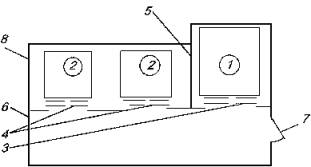
Rice. 2 .Examples of placing an elevator for firefighters in a separate (fenced-off) mine with a common elevator hall with other elevators:
1 - lift for firefighters; 2 - passenger lifts; 3 - fire door of the elevator shaft for firefighters with a fire resistance limit of EI 60; 4 - fire door of the passenger elevator shaft with fire resistance E 30; 5 - building envelope of the elevator shaft for firefighters with fire resistance REI 120; 6 - fireproof partitions of the 1st type, enclosing the elevator hall; 7 - fire door of the 2nd type of the elevator hall, smoke and gas tight design; 8 - enclosing structures of the passenger elevator shaft with fire resistance limits established by the relevant SNiP
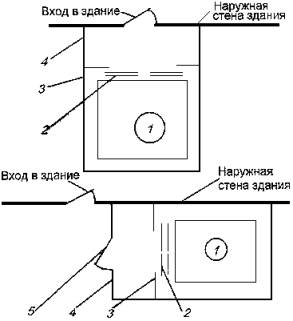
Rice. 3 .Examples of placing an elevator for firefighters outer wall public or industrial building (structure):
1 - lift for firefighters; 2 - fire door of the elevator shaft for firefighters with a fire resistance limit of EI 60; 3 - enclosing structures of the shaft with a fire resistance limit of REI 120; 4 - fireproof partitions of the 1st type, enclosing the elevator hall (vestibule); 5 - fire door of the 2nd type of the elevator hall (tambour) in a smoke and gas tight design
* It is allowed to use materials with a smoke generation coefficient up to 750 m 2 /kg inclusive.
Elevator with the mode of transportation of fire departments - as such, the most ordinary passenger or cargo elevators can act, which are additionally equipped with special systems for control, as well as fire protection and special communications, which, in addition, should be able to ensure the movement of fire services to the desired floors of any building where it is equipped during fires. According to Part 2 of Clause 1 of Article 90 of Federal Law No. 123 for structures and buildings, it is necessary to constructively provide devices for the possibility of lifting the fire service, regardless of either the height or the number of storeys of structures and buildings.
Design features and specifications
Elevator structures for the transportation of fire fighting crews belong to common system engineering communications inside buildings of any type. This is one of the options for fire-fighting means that can be used to ensure the movement of rescue and fire services to the necessary floors of any buildings in order to carry out measures to localize the fire and extinguish the fire, to carry out rescue activities.
The main criteria for elevators, which are intended for employees of fire crews, must satisfy the following indicators:
- the carrying capacity of elevators installed in residential buildings is at least 630 kilograms;
- load capacity of elevators mounted in industrial or public buildings - not less than 1 ton;
- the dimensions of the elevator cabin inside residential premises, buildings are determined by SNiPs number 2. 08. 01;
- as for industrial or public type buildings, here you need to be guided by the rules prescribed in PUBEL;
- on the roof of the elevator cabin, according to NPB - 250, it is necessary to equip a hatch for the penetration of a fire service employee in full gear.
As for the dimensions, they should be calculated based on the fact that for the transportation of one person on a stretcher, at least 2,100 mm x 1,100 mm of the area of the elevator space will be required.
It is also necessary to take into account the requirements fire safety to freight and passenger elevators. They, in particular, indicate that any elevators that move at a speed of more than one meter per second must be equipped with a button to enable a special mode of operation in fire hazardous conditions. It is necessary to ensure automatic activation of this mode. At the same time, such elevators must ensure the return of passengers to the nearest safe area (usually the first floor) and mechanically open the door to allow evacuation from the cabin.
It is desirable that elevators be made of the most non-combustible material, and that the materials from which they are made do not emit harmful toxic substances in case of contact with direct flame.
A more detailed technical specification is specified in the Federal Law "Technical Regulations on the requirements for fire safety", dated August 22, 2008, number 123 - FZ (as amended on June 03, 2016).
Fire safety requirements for elevators require the presence of a special switch that can be used to manually activate the transport mode of fire fighting units. By turning the key to the ON position, you can turn on the corresponding mode. By turning the key to the Bypass position, the elevator returns to normal operation.
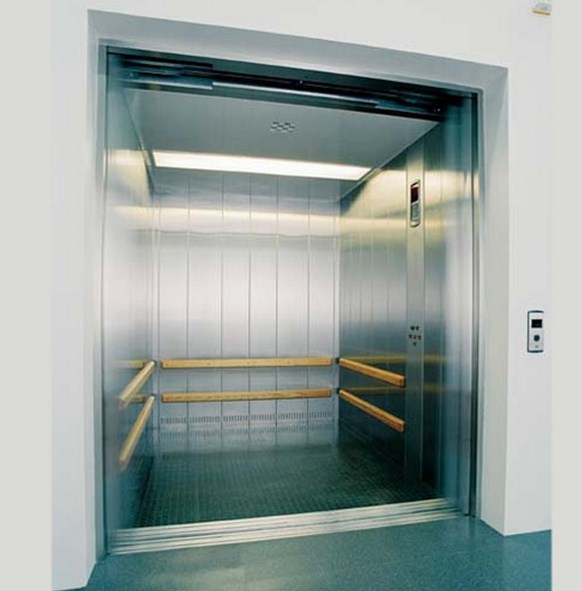 Inside the elevator cabins, instructions should be posted on how to switch the elevators to the fire fighting transport mode, how to use the elevator in case of a fire or a localized fire.
Inside the elevator cabins, instructions should be posted on how to switch the elevators to the fire fighting transport mode, how to use the elevator in case of a fire or a localized fire.
Detailed fire requirements for elevators are specified in the relevant regulations. These are: NPB 250 - 97 under the name "Elevators for transporting fire fighting units inside structures and buildings", GOST 28911, PUBEL standards, as well as in SNiP 31 - 01 - 2003 "Residential and apartment buildings". In addition, the necessary provisions can be extracted from the Federal Law of June 10, 2012 No. 117 - FZ.
GOST for fire elevators
There are specially designed State Standards for freight and passenger elevators GOST-R 52382 " Passenger elevators. Elevators for firefighters. It implements all the requirements of the special those regulations called "On the safety of elevators." 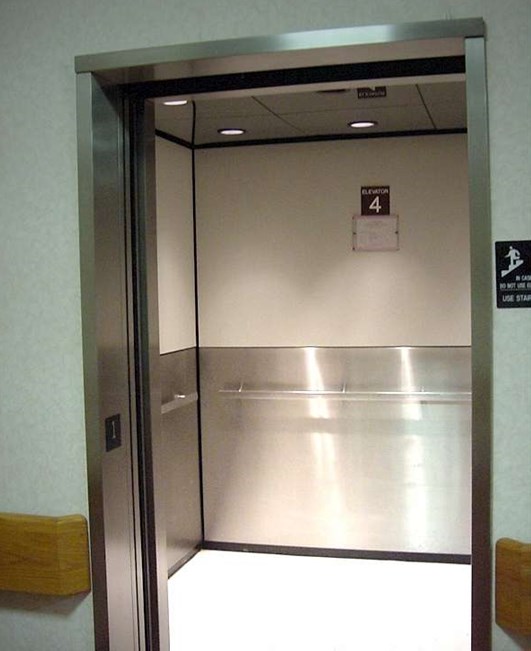
These documents regulate the arrangement of both new designs of elevator cabins and those that are being replaced. The given GOSTs can also be taken into account during the modernization of obsolete elevators.
If the elevators for the transportation of fire departments comply with GOST standards, then material damage and human casualties in the event of a fire will be minimal.
Fire safety \\ 29.03.2012 15:46 \\ \\ Moscow
There are several questions that arise in the design and construction of facilities, for which regulatory documents do not provide unambiguous answers. In particular, about the specifics of the design and use of elevators for fire departments.
Regulatory side of the issue
Currently, on the territory of the Russian Federation, the need to install elevators with the operating mode "transportation of fire departments" (hereinafter referred to as elevators for firefighters) for designed, under construction and reconstructed objects (hereinafter, an object means a building, structure, structure or outdoor installation) is established by part 15 of article 90 federal law from 22.07.2008 No. 123-FZ "Technical regulations on fire safety requirements" (hereinafter FZ-123).
For those designed according to previously existing standards and put into effect before 05/01/2009. objects, such a need is determined by clause 8.10 of SNiP 21-01-97 * "Fire safety of buildings and structures" and clause 1.143 * of SNiP 2.08.02-89 * " Public buildings and buildings."
At the same time, in accordance with the requirements of part 15 of article 90 of FZ-123, it was established that elevators for firefighters should be provided in each fire compartment of objects of class F1.1 (buildings of preschool educational institutions, specialized homes for the elderly and disabled (non-apartment), hospitals, dormitories of residential educational institutions and children's institutions) with a height of more than 10m, objects of class F1.3 (multi-apartment residential buildings) with a height of more than 50m, objects of other classes of functional fire hazard with a height of more than 28m, underground car parks having more than two floors.
In accordance with the requirements of clause 8.10 of SNiP 21-01-97 * "Fire safety of buildings and structures", it is established that elevators for firefighters should be provided in each fire compartment of buildings of class F1.1 with a height of more than 5 m, buildings of all classes of functional fire hazard with a height of more than 28m (excluding buildings of class F1.3).
In accordance with the requirements of clause 1.143 * SNiP 2.08.02−89 * "Public buildings and structures" it is established that elevators for firefighters should be provided in public buildings with a height of 10 floors or more.
As you can see, in the current regulatory documents there are some contradictions in the requirements for providing facilities with elevators for firefighters.
Technical requirements for elevators for firefighters are set out in the Technical Regulations on the safety of elevators, approved by the Decree of the Government of the Russian Federation of 02.10.2009. No. 782 "On approval of the technical regulation on the safety of elevators", GOST R 53296-2009 "Installation of elevators for firefighters in buildings and structures. Fire safety requirements” and NPB 250−97 “Elevators for transporting fire departments in buildings and structures. General technical requirements". Moreover, the first two documents apply to objects being designed, under construction and reconstructed, and the last one to those designed according to previously existing standards and built before the first two documents were put into effect.
There are several questions that arise from time to time in the design and construction of facilities, for which regulatory documents do not provide unambiguous answers.
The first one: is it possible to use firefighters lifts as rescue lifts for people with limited mobility?
The fact is that in accordance with the requirements of clause 3.45 of SNiP 35-01-2001 "Accessibility of buildings and structures for people with limited mobility" (the list of persons included in the MGN is listed in Appendix A to SNiP 35-01-2001), if according to the project, it is impossible to ensure the evacuation of these groups of the population beyond required time(time from the moment of the fire to the moment of exposure to the critical values of its dangerous factors per person), then in order to save them on the evacuation routes, a fire-safe zone should be provided, from which they can evacuate for a longer time or stay in it until the arrival of rescue units. And in accordance with the requirements of clause 3.47 of SNiP 35-01-2001, fire-safe zones should be provided near vertical communications - such communications can also be an elevator for firefighters. In addition, in accordance with the requirements of clause 6.26 of SNiP 31-06-2009 “Public buildings and structures”, in the buildings of hospitals of medical and preventive and social institutions, the doors of an elevator that meets the requirements for elevators for firefighters must go to the indicated fire-safe zones.
The second question concerns the design of elevators for firefighters at one-story facilities of the functional fire hazard class F 5.1 ( industrial buildings, structures, structures) and F 5.2 (warehouse buildings, structures, structures) with a height of more than 28 m, as well as on outdoor installations with a height of more than 28 m, designed as part of manufacturing enterprises. It is not entirely clear why designing an elevator for firefighters at a one-story facility, but the norm requires it!
Yes, in such a variety of conflicting regulatory requirements regarding the issue under consideration, it is elementary for the average specialist of a design or operating organization to get confused.
And why is he needed at all, this elevator for firefighters?
Indeed, what are elevators for firefighters for?
In accordance with clause 4.1 of NPB 250−97 and clause 4.1 of GOST R 53296−2009, elevators for firefighters are integral part complex of engineering equipment of objects for various purposes, as well as one of the types of fire-technical means that ensure the movement of fire departments to the floors to perform work to save people, detect and extinguish a fire.
So why are firefighters afraid of firefighter elevators?
Well, we provided an elevator for firefighters in the project documentation, built the facility and put it into operation, and what's next? As practice shows, elevators for firefighters are used by firefighters themselves when extinguishing fires in buildings equipped with such elevators, in no more than 2% of cases!!! It turns out that expensive equipment is not in demand by the main consumers. That is, the regulatory documents provide an inefficient technical requirement!? The matter is quite different.
There are several problems practical use elevators for firefighters by the firefighters themselves, which do not allow them to be used effectively.
The first of these is psychological. Indeed, especially after the fire at the Ostankino television tower, when three people died during extinguishing, including a high-ranking employee of the Moscow Ministry of Emergency Situations, fire extinguishing leaders (hereinafter referred to as RTP) are afraid to use elevators for firefighters. Indeed, not a single sane RTP, realizing that he is responsible for the lives of his subordinate fighters, will ever send them to rise to a height with the help of elevators. What is he afraid of? After all - ideally - if the elevator for firefighters is designed in accordance with the requirements normative documents, then this is one of the most invulnerable places in the building in terms of fire (the elevator is located in a shaft with a fire resistance limit of enclosing structures REI 120, the doorways of the shafts are protected by fire doors with a fire resistance limit of EI 60, an outside air boost of at least 20 Pa is provided in the shaft, power elevator units are provided with power supply according to the first category of power supply reliability, there is a connection with a fire post). However, the RTP puts the main semantic emphasis in the previous sentence on the words “ideally”, and what kind of elevator is in front of him and his fighters, he does not know, and if he does not know, then he will not use it! And he will be right in his own way.
The second problem follows directly from the first, it is a banal ignorance of the equipment and the rules for its use. Neither in the previous combat charter fire brigade, neither in the current Procedure for extinguishing fires by fire departments (enacted by order of the Ministry of Emergency Situations of the Russian Federation of March 31, 2011 No. 156, registered with the Ministry of Justice of the Russian Federation on June 9, 2011 No. 20970) does not say a word about the use of elevators for firefighters.
And what - to refuse elevators for firefighters?
No. This cannot be done! For the following two reasons: firstly, this is not possible, since the requirement to install them is regulatory requirement. Secondly, the use of elevators for firefighters will help save firefighters a lot of effort when climbing to a height and delivering fire-technical equipment that will be needed to localize and extinguish a fire, and, possibly, to save people.
However, to solve these problems, as always, a systematic approach is needed. You should start from the stage of developing a preliminary concept of the object, when its main parameters are determined. Here it is important to determine the need for an elevator for firefighters in principle (depending on the functional fire hazard class of the object, its height and number of storeys).
Further, at the design stage of the facility, it is necessary to determine the number of elevators for firefighters, their installation locations, their speed and geometric parameters, and the smoke protection device for elevator shafts and halls. At the same time, it is important to link and optimize the number and installation locations of elevators for firefighters, taking into account their subsequent use, including for rescuing people with limited mobility.
At the same time, it is important that all these design solutions be described in the section of the design documentation "Measures to ensure fire safety", which must be carried out in accordance with the requirements of clause 26 of the Regulation "On the composition of sections of design documentation and requirements for their content", approved Decree of the Government of the Russian Federation of February 16, 2008 No. 87 and justified in accordance with the requirements of Part 6 of Article 15 of the Federal Law of December 30, 2009 No. 384 "Technical regulations on the safety of buildings and structures" (hereinafter FZ-384).
In case of forced and justified deviations from the requirements for equipping facilities with elevators for firefighters, a set of justifications should be carried out taking into account the requirements of Article 6 of the Federal Law-123, Part 6 of Article 15 of the Federal Law-384, Part 2 of Article 4, Part 1 of Article .6, part 2, article 7 of Federal Law No. 184-FZ of December 27, 2002 "On technical regulation".
At the construction stage of the facility, it is important to comply with the provisions of the design documentation for the reliability of the power supply of the power units of elevators for firefighters, their other parameters that affect the safety of their use in case of fire.
And finally, at the stage of operation of the facility, it is necessary to organize the interaction of the organization operating it and the territorial division of the state fire service of the Ministry of Emergency Situations of Russia, the divisions of which, in the event of a fire, will be involved in extinguishing it. At the same time, it is extremely important to develop and coordinate with the specified unit operational plan extinguishing fires at the facility, including determining the procedure for using elevators for firefighters.
During the operation phase, special attention should be paid to the organization of the operation of elevators for firefighters in accordance with the requirements of the Technical Regulations on the safety of elevators, as well as the operability and safety of using smoke ventilation systems in elevator shafts and halls to ensure reliability.
______________________
Razumnov, Sergei
Head of Expertise and Design Department
LLC "Institute of Integrated Security"*,
*part of the Innotech group of companies, develops comprehensive solutions to ensure fire safety at civil and industrial construction sites
Fire elevators designed for transportation of fire departments are usually installed in buildings with a large number of people, where in the event of a fire, rapid mobilization, evacuation of passengers and delivery of fire departments to the fire site is necessary. The fire elevator must be designed in such a way as to freely transport crews of several people to the desired floors, as well as be fully equipped with the necessary equipment.
First of all, the load capacity of fire elevators, according to the requirements of the technical regulations, must be at least 630 kg in order to be able to transport a large number human. In addition, due to their specificity, fire lifts must be suitable for transporting rescued people and people on stretchers, and therefore, they must have appropriate dimensions - the dimensions of the cabin according to the regulations must be at least 1 m 10 cm x 2 m 10 cm, while the width doorway- not less than 80 cm. Special attention in the technical regulations is paid to the roof of the elevator car. It must be equipped with a hatch, the dimensions of which should not be less than 50 x 70 cm, while for fire elevators, the load capacity of which is 630 kg, it is allowed to reduce the size of the hatch to at least 40 x 50 cm. Also, fire elevators must have special materials for finishing and cladding of walls, ceilings, compartment cabins. First of all, they must be especially strong and have a flammability group G2, that is, moderately flammable, the duration of independent combustion of which is not more than 30 seconds, as well as a flammability group B2, that is, moderately flammable, having a critical heat flow plane value of not more than 35 kilowatts per square meter. In addition, all materials in the elevator car must belong to the moderate toxicity group.
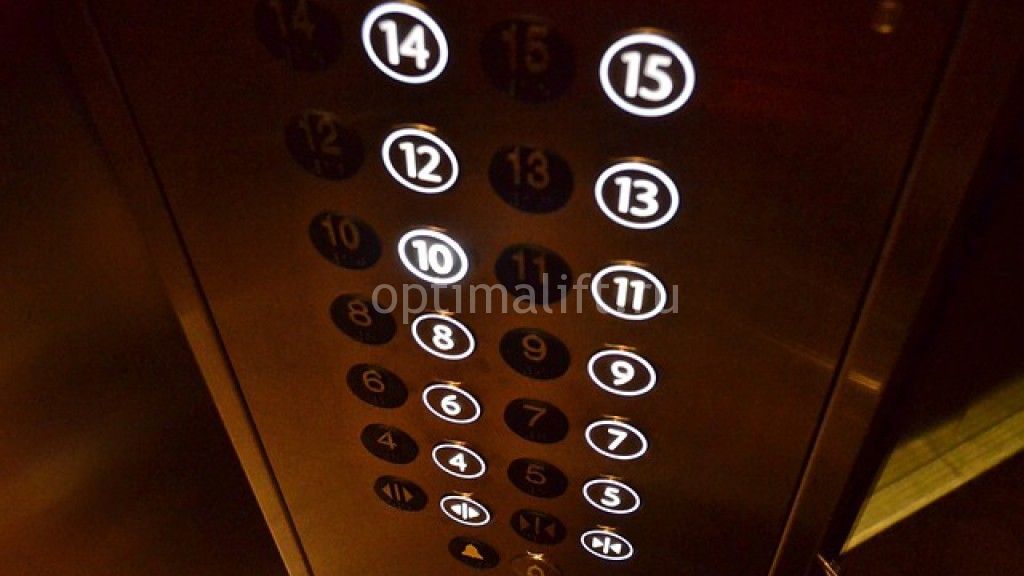
It is important to note that elevators for transporting firefighters must be able to operate in the modes " fire hazard"and" Transportation of fire departments. Different modes are necessary for the elevator to operate correctly in both of these situations, and be able to deliver passengers and victims to the lower floor in any situation, as well as promptly deliver fire departments to the fire site. It is also necessary that in the “Transportation of fire departments” mode, the elevator car was equipped with means for connecting to a two-way intercom system between the control room or the central control panel of the fire protection system, as well as with the main landing floor. At the same time, in order to save time, voice communications from the elevator car should be carried out without the use of handsets.






